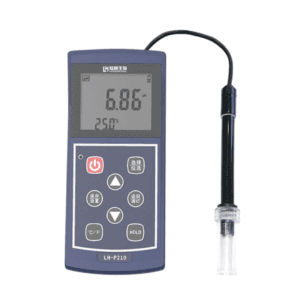$845.00 – $990.00Price range: $845.00 through $990.00
The Analytical balance is a highly sensitive laboratory instrument used in chemical analysis to measure the mass of chemicals and objects accurately and precisely up to 0.01mg. Available with external or internal calibration capabilities and 60-220g capacities, allowing the user to personalize their balance model for their needs.
Analytical balance works on the principle of “magnetic force restoration.” It is an electromagnetic balance that measures the mass of an object using an electromagnet. These balances do not directly measure the mass; rather, they measure the force that acts in the downwards direction on the balancing pan.
Conduct Science offers Analytical Balances.
For a balance to measure up to 6100g, please see our precision balance here

Conduct Science is a premier manufacturer of research infrastructure, born from a mission to standardize the laboratory ecosystem. We combine industrial-grade precision with a scientist-led tech-transfer model, ensuring that every instrument we build solves a real-world experimental challenge. We replace "home-brew" setups with validated tools ranging from microsurgical suites to pathology systems. With a track record of >1,600 institutional partners and hundreds of citations, our equipment is engineered to minimize human error. We help you secure more data for less of your budget, delivering the reliability required for high-impact publication.


bool(false)

bool(false)
This scale features a combination of built-in electromagnetic sensor technology and precision mechanical components to configure exceptionally accurate weight determinations.
-Readibility 0.1mg with a reapeatability of 0.2mg
-Internal of External calibration capabilities
-60, 100, 110, 120, 160, 200, 210, 220 gram capacities
– Novel design with five-side full-transparent windshield.
-A new-generation electromagnetic balance weight sensor guarantees high precision.
-Application programs such as automatic fault detection, four-point linear calibration and over-load protection.
-Ultra-large LCD display brings clearer and more comfortable visual sense to operator.
-Multiple functions guarantee easy and reliable operation, including auto-counting, unit conversion (metric caret, gold ounce, etc.),
stability, full-scale faring, zero-memory, etc.
-Built-in RS232C output interface guarantees direct connection to external equipment such as computer and printer.
-Built-in lower weighing hook guarantees convenient use.
Analytical balance works on the principle of “magnetic force restoration.” It is an electromagnetic balance that measures the mass of an object using an electromagnet. These balances do not directly measure the mass; rather, they measure the force that acts in the downwards direction on the balancing pan. An electromagnetic motor measures this force and ultimately determines the mass of the object. The motor requires an electric current for this purpose, and this current is directly proportional to the weight of the object and thus can be used to measure the object’s mass. This mass is displayed on the balance screen. Many balances possess a “null detector” that uses a light source to indicate when the object’s weight is equal to the electromagnetic forces.
The electronic analytical balance consists of a stainless-steel balancing pan enclosed within a glass chamber, which shields against the interference of air currents or vibrations while weighing. The mass to be measured is placed in the balance pan within the weighing chamber. The instrument’s front is provided with a digital display system that displays the measured mass. A power button along the LCD screen turns on the balance. Furthermore, a “TARE” button is used to eliminate container mass and reset the balance at zero. In addition, there are buttons to set the measuring mode (the apparatus can measure the mass in different units) and a print button.
Conduct Science’s electronic analytical balance comes with easy external calibration and can measure mass in different units like grams, pounds, ounces, and carats. It has a pan size of 9cm which is well suited for measuring the mass of acute substances. This analytical balance can measure accurately up to 1×10-4 grams and has a measuring range of 210grams. It also has a built-in port to transfer data to the computer or print it.
Analytical balance has a wide range of weighing applications in the pharmaceutical industry, food and plastic industries, quality assurance cells, and chemical laboratories. For example, Abu Bakar et al. (2019) studied how milk-drug tablet formulations can increase the solubilization of poorly water-soluble drugs. They used an analytical balance to measure the mass of compounds before adding them into scintillation vials during tablet formulation.
Monitoring a Transesterification Reaction
Tubino et al. (2018) established a monitoring system using an analytical balance to observe the changes during a transesterification reaction. In this system, they connected a round bottom flask in which the reaction was occurring to a peristaltic pump and phase separators. The pump was connected to an electronic analytical balance that was ultimately connected to a laptop in which the entire research data was recorded. For the transesterification reaction, they took 700g of soyabean oil and 120g of methanol and catalyzed it with 30% m/v sodium, methoxide solution in methanol in the round bottom flask. The reaction was stirred using a magnetic stirrer at increasingly faster speeds. The liquid product of the transesterification reaction is pumped and passed through the phase separators that remove glycerol (transesterification byproduct) and air bubbles. Finally, the liquid reaches the beaker placed in the weighing pan of the analytical balance, which contained a small piece of cotton to dampen the oscillations produced by the peristaltic pump. They constantly monitored the mass until the reaction reached equilibrium with the help of the balance and recorded mass data on a datasheet in the computer system. Then they plotted the mass curve. They concluded that the addition of catalyst at different rates decreases the mass over time, and the slope of the mass-time graph shifts to negative as the temperature increases. They also deduced that the mass decreases when methanol is added to the oil.
An analytical balance is a simple and easy-to-use instrument that can measure precisely and accurately up to four places to the right of the decimal point, i.e., very small values can be measured with it. However, random environmental factors like air currents, temperature, static charge, etc., can cause drift in analytical balances. Drift means ‘unstable mass readings,’ and there are several ways to avoid it. For example, the humidity levels of the lab should be around 40% at the time of weighing equipment installation to get rid of static charge. Moreover, the experimenter should not store the mass in a plastic container after weighing it. Similarly, the constant temperature must be maintained throughout the weighing experiment.
Tubino, M., Oliveira, A. G., & Salomão, A. A. (2018). Continuous monitoring of a transesterification reaction using an analytical balance. Journal of the Brazilian Chemical Society, 29, 200-204.
Bernard Y., C., & Angelo, G., G. (2019). Introduction to the Analytical Balance.
Bakar, S. Y. B. A., Salim, M., Clulow, A. J., Hawley, A., & Boyd, B. J. (2019). Revisiting dispersible milk-drug tablets as a solid lipid formulation in the context of digestion. International journal of pharmaceutics, 554, 179-189.
| Weight | 9.5 lbs |
|---|---|
| Dimensions | 48 × 37.5 × 51.5 cm |
| Capacity | 60g, 100g, 110g, 120g, 160g, 200g, 210g, 220g |
You must be logged in to post a review.
There are no questions yet. Be the first to ask a question about this product.
Reviews
There are no reviews yet.